
Here is why Paris is always a good idea
Remember: A stranger is a danger, regardless of what language he speaks.
Having lived in Paris (well, not in the heart of the city but in the suburbs) for over eight years, I can safely and confidently say that I know this city and its off shoots quite well. This is not exactly a tourist guide but my humble attempt to write a few lines about this city for those who are not in-the-know.
I came here in 2007 when I hardly spoke more than a few basic lines in French. I had simply taken a crash course in French from Alliance Française, in London, before starting for France. I had been here as a tourist way back in 2001, only for three days but that’s hardly enough to get a feel of the place.
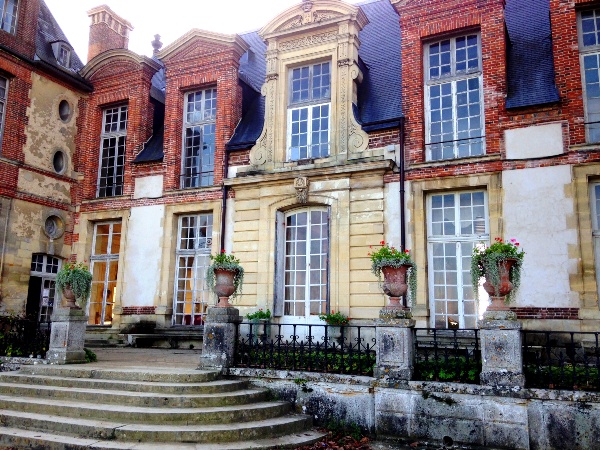 The main entrance of the chateau of Parc de Thoiry. Photo: Supriya Arcot
The main entrance of the chateau of Parc de Thoiry. Photo: Supriya ArcotTo begin with, the French are not as implicit (to the extent of being ambiguous) as the English. They are quite open and explicit in their communication, much like South Asians. If they don’t like something, they say it bluntly, unlike the English who will raise perhaps one, and just one, eyebrow to show their displeasure. The French are fiercely possessive about their language. They don’t tolerate its slaughter and, unlike the English, will rush to correct you when they hear you struggling with it. Clumsy French is more welcome than perfect English here.
The people are quite accessible otherwise, though they don’t go out of their way to befriend you or help you. Luckily, it took us a very short while to settle in, thanks to our neighbours and friends, because we managed to make some.
Belongings
Paris, even today, after the birth of newer and more enthralling countries like Herzegovina (it’s the most exotic country name I could think of), tops in the number of tourists by a very big margin year after year. The Eiffel Tower and Nice (located down south and has a more Mediterranean climate) are popular destinations for marriages.
 A house in Les Marais. Photo: Supriya Arcot
A house in Les Marais. Photo: Supriya ArcotIf you are here as a tourist, then you’d be advised to be careful with your belongings. No place on Earth is immune to cheating and robbery, and Paris is no exception. Central Paris, especially its tourist spots, is filled with gypsies, illegal immigrants, beggars (yes, you read that right – they do exist in these parts of the world too) and street walkers, to use a polite term. They are ‘invisible’, meaning they don’t carry boards around their necks. It’s tough to identify them unless you are in-the-know.
It will do a world of good for a traveller to carry his belongings safely. A good idea, which works for me, is to carry a smaller wallet with your ‘real’ essentials inside your coat and carry a bigger or eye catching bag, with expired credit cards and a few pennies, hanging on your shoulder. It’s normal and common to feel a happy lump in your throat when you hear your own vernacular or a familiar language like Tamil, Punjabi, Arabic or Bengali. One needs to be careful not to get too carried away in conversations with such ‘known’ folk. A stranger is a danger, regardless of what language he speaks.
Public transport
The city of Paris is well-knit by a network of metro lines, main lines, trams and buses. You are never more than 10 minutes away from the nearest public transport stop. It’s a city that never sleeps so the lines run very late into the night and start as early as 4am.
The ‘innocent’ newcomer can be forgiven for believing that Paris is all, if not all then mostly, about sipping wine, nay and merlot from crystal glasses and viewing the Eiffel tower from his or her (hotel) room with a view. There are some pockets in the heart of the city which are best avoided after sunset.
 A train station in the city. Photo: Reuters
A train station in the city. Photo: ReutersThe ‘locals’ here are the avoidable types who are street smart and dangerous, each one more sinister than the other. Most of the women and men are dressed to the hilt with shiny gold earrings, bracelets, hair pieces, fake long hair, jazzy, shiny colourful satins and faux leather shoes, pants and jackets on any part of the day or year. They spell danger from far. I am sure most of them work hard for their money, whichever way you look at it, but it’s better to stay away from them as much as possible.
They know the city and the metros like the back of their hands. They don’t belong to any particular race or creed .They come in all colours and sizes .They will not hesitate to pinch or punch their immediate neighbour in a crowded and packed compartment for the silliest reason. I can narrate many first-hand incidents of acid and knife attacks in broad daylight.
Be prepared to hear innumerable languages and equally innumerable accents of any given language. Even after so many years in Paris, when I hear English in any accent I feel a nostalgic lump in my throat and I am reminded of the decade I spent in England.
Eating out
Paris is known for its cafes. Crêpes and galettes are the specialty here, along with their wine and cheese. The city never sleeps, I repeat. Even when travelling in the dead of the night, you can see people hanging out in pubs and bars having a ‘cuppa’, many by themselves – quietly contemplating.
If you are lucky to get into a Michelin star restaurant, then the experience is worth it. In my entire life, I have lunched only once in such a restaurant. It was in L’Arpége run by Alain Passard and it was worth every cent the €600 the bill came to, for two people. He grows his own vegetables and is a specialist in vegetarian dishes, which is rare for the French. Even to this day, after so much publicity and awareness of vegetarianism, they look at you in shock when you say you are a pure vegetarian.
“What? Not even eggs? What do you do for proteins?” they ask.
I need to explain to them, with great patience, that there are over 2000 varieties of lentils which are a part of our daily diet. I am not advocating vegetarianism here; just making a point.
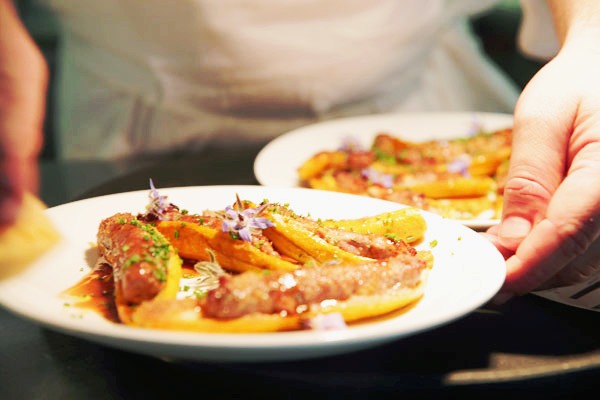 Photo: Reuters
Photo: ReutersIf you want authentic North Indian food then there are good restaurants like Ratn, Old Jawad and India, all in the heart of Paris. The bill should not come up to more than €300 for a family. Cheaper alternatives can be found in every nook and corner but then, it goes without saying, we need to compromise on the quality of the food too. There are a myriad of eateries to cater to the Mediterranean palate – the area of Le Marais being my favourite for pita hummus and falafel.
I am yet to see a complete vegetarian joint in France. Even so-called salad bars come with the inherent understanding that they will carry at least raw fish. Crêperies, boulangeries, butcheries, fromageries and wine bars can be seen at the drop of a hat.
No eyebrows are raised when a single female walks in any time of the day, lunch time or even tea time, and asks for a glass of wine. This, I suppose, happens only in Paris.
The French include a lot of chocolates in their daily diet. Its iron rich, they say. I still wonder how these women maintain their slim waists. Many traditional families make wine and chocolates themselves at home, like South Asians make their own pickles and papars.
In remote parts where there are no pizzerias or McDonald’s chains, the locals have their own mobile pizza service at public places like the village church or mayoral office.
Many star chefs offer classes for short durations too. I was lucky to attend a dessert making class, for three hours, with Alain Ducasse. Agreed that each dish took more than a kilo of butter and concentrated cream, which is over fatty for my taste and waist, but at the end of it, it tasted good and was worth the fees of €300. After all, you don’t eat desserts daily, so if it’s once in a while then why not make it real by using real butter and cream and not their low calorie substitutes. Plus, all said and done, the real thing has more nutritional value.
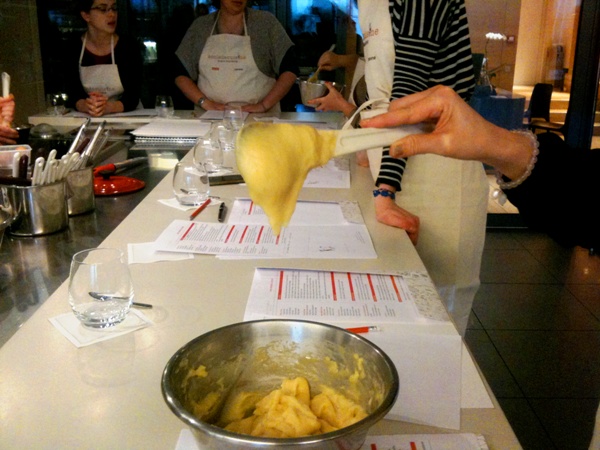 A cooking class in progress. Photo: Supriya Arcot
A cooking class in progress. Photo: Supriya ArcotFamily outings
France is a very family-oriented country. During the two wars, with the men out to ‘work’, the women were left to fend for themselves. They started working and earning. The feminist movement had started. The women had tasted blood.
They didn’t want to be tied down like their mums and grand-mums. They didn’t want to get married and have children. They had experienced ‘independence’. This led to a major drop in the population growth. To maintain the ratio and lure women back into the family fold, the government started offering a myriad of facilities like nanny services, work from home options, a substantial amount of money for each child born and the likes. So, the women could then work and also have a family at the same time.
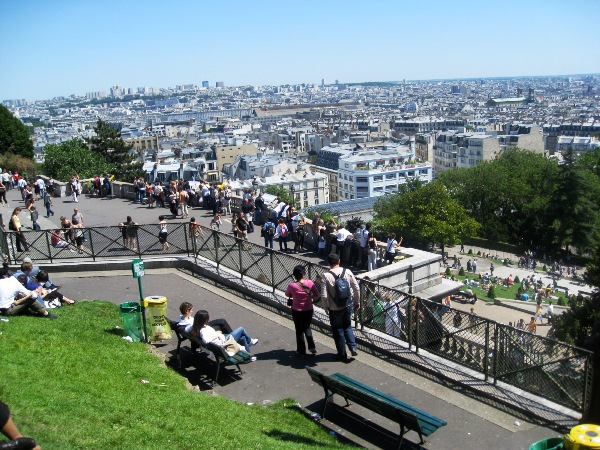 A view of the city from the basilique of Sacré Coeur, a 19th century church of sacred heart, just a couple of steps away from Piggale ( one of the ‘adult’ places in the heart of the city). Photo: Supriya Arcot
A view of the city from the basilique of Sacré Coeur, a 19th century church of sacred heart, just a couple of steps away from Piggale ( one of the ‘adult’ places in the heart of the city). Photo: Supriya ArcotParis carries several lucrative destinations for the entire family. Cité des enfants offers many science related attractions for children of all ages. Le Jardin d’Acclamatation is a 200-year-old park still maintained in its original design. Le Jardin du Luxemburg, a mere couple of steps away from Sorbonne University, is a magnet for children with activities like pony rides, puppetries, mini-boat races, drive-in zoos, cathedrals and not to mention castles, which are abound.
They organise Easter egg hunts and other children’s activities and is a major attraction for the children during holiday seasons. Strawberries and lavender picking farms can be found in plenty if you are willing to drive a teeny weeny bit away from the actual city. They make good destinations for children’s parties.
 A drive-in animal zoo at Parc De Thoiry. Photo: Supriya Arcot
A drive-in animal zoo at Parc De Thoiry. Photo: Supriya Arcot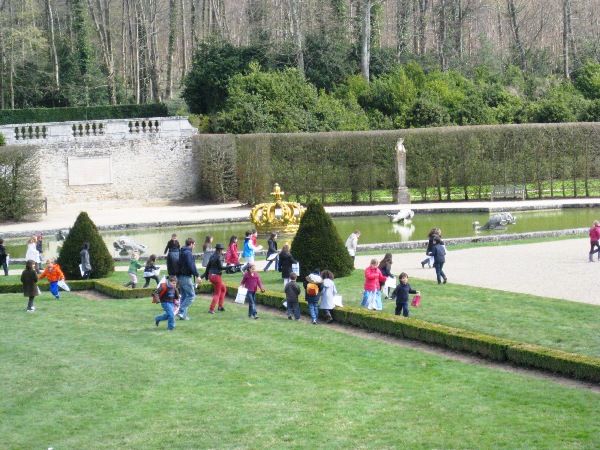 An egg hunt in progress in le chateau de Vaux Le Vicomte. Photo: Supriya Arcot
An egg hunt in progress in le chateau de Vaux Le Vicomte. Photo: Supriya Arcot A peacock dancing inside a cage as birds and small animals (like mongoose) are kept inside the cages in all zoos. Photo: Supriya Arcot
A peacock dancing inside a cage as birds and small animals (like mongoose) are kept inside the cages in all zoos. Photo: Supriya ArcotThe holocaust museum is another one of a kind – it should be ‘felt’ and not just ‘seen’. Go there only if you dare. Each time I visit it, I come back with an awkward lump in my throat. It’s right in the heart of Paris, in Le Marais, which is a very historic pocket of the city.
Remember, I told you, this is not your routine travel guide, so I am not mentioning the obvious Eiffel Tower, The Louvre (which hosts the Mona Lisa), Disneyland or Sienne.
Fashion
No write-up on Paris is complete without at least a passing mention of the fashion. They don’t call Paris the fashion capital for nothing. People are very figure-and-fashion conscious. It’s rare to spot a fat and flabby figure, male or female, in this part of the world. I mean they do exist, but it’s rare.
Everyone is neatly and immaculately dressed all the time. Rarely will you see a shabbily or carelessly dressed person (like the loosely called chaves in England) on the street. The main street of Paris, Champs-Élysées, is one nonstop fashion runway with grand shops on both sides, the Arc De Triomphe at one end and l’Arche de la Défense on the other.
 Photo: Reuters
Photo: ReutersWith so many attractions to offer in the fields of fashion, cuisine, sightseeing, leisure, and religion, Audrey Hepburn was right when she said,
“Paris is always a good idea.”




COMMENTS (17)
Comments are moderated and generally will be posted if they are on-topic and not abusive.
For more information, please see our Comments FAQ